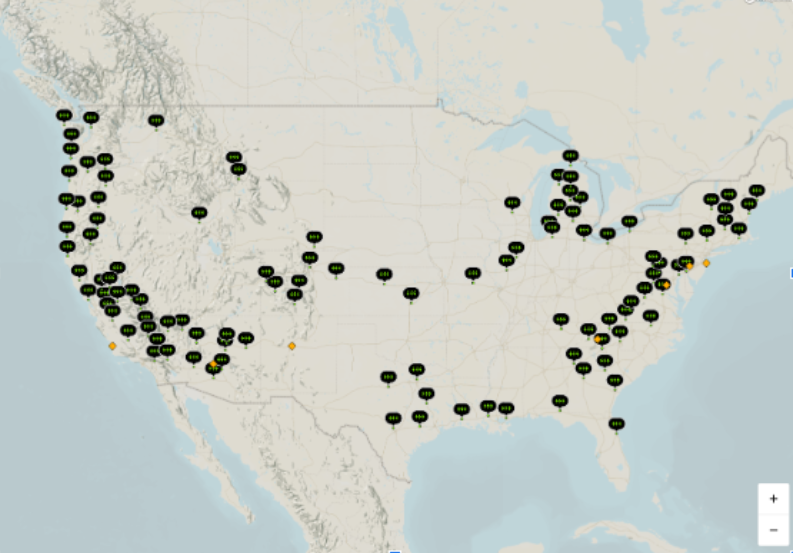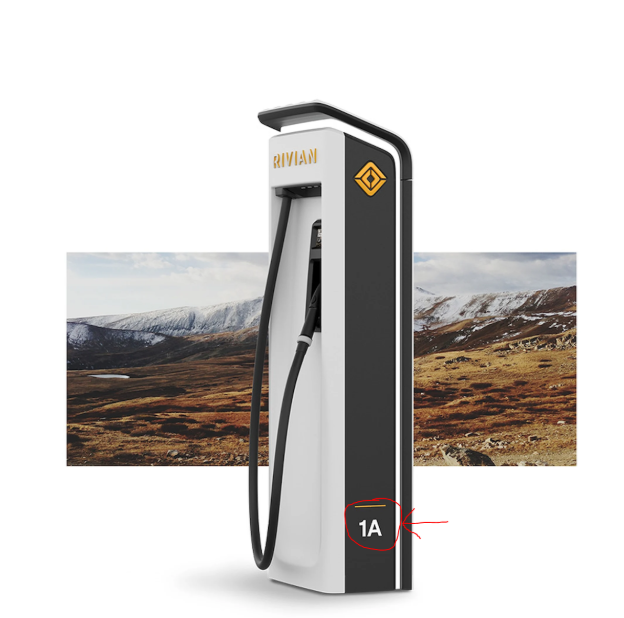Maximizing Rivian Charging Efficiency at the Rivian Adventure Network (RAN)
March 23, 2025

Rivian Adventure Network charging stations across North America.Source: rivian.com/experience/charging
TL;DR:
Rivian Adventure Network (RAN) chargers share power (usually 300kW per group of chargers like 1A, 1B, 1C). This means your Rivian's charging speed can slow down if others are charging in the same group. For example, at a 6-stall station labeled 1A, 1B, 1C, 2A, 2B, 2C, if group "2" has cars and group "1" is empty, choose a stall starting with "1" to charge faster. Other tips: arrive with a lower battery, charge to around 70%, and use your Rivian's navigation to precondition the battery. Also, battery temperature and software updates matter.
I. Understanding the Rivian Adventure Network and Efficient Charging
The Rivian Adventure Network (RAN) represents a significant investment by Rivian in building a dedicated charging infrastructure for its electric vehicles. This network aims to provide Rivian owners with a reliable and fast charging experience across the United States and Canada, facilitating both everyday use and longer journeys. Initially exclusive to Rivian vehicles, the RAN has recently begun to open its doors to all electric vehicles, marking a pivotal step towards broader EV adoption.
This increased accessibility, while beneficial for the overall electric vehicle landscape, introduces a new dynamic to charging at RAN locations. With more vehicles potentially vying for the available power, understanding how the system distributes energy becomes paramount for Rivian owners seeking to minimize their charging time.
Efficient charging is particularly crucial during road trips, where time spent at charging stations directly impacts the overall travel duration. For many drivers, the ability to quickly replenish their vehicle's battery is a high priority. A key factor influencing charging speeds at the Rivian Adventure Network is the concept of load sharing. Comprehending how power is allocated among multiple vehicles charging at the same station is essential for Rivian owners to develop effective strategies for maximizing their charging efficiency.
II. How Load Sharing Works at Rivian Adventure Network Stations
A typical Rivian Adventure Network station comprises power cabinets that serve multiple charging dispensers, also known as stalls. These dispensers are labeled using a combination of numbers and letters, such as 1A, 1B, 1C, 2A, 2B, and 2C. This labeling convention is consistently observed across various sources, indicating a standardized approach within the RAN infrastructure.
The fundamental principle behind load sharing at these stations is that a group of dispensers is typically connected to a single power cabinet with a defined maximum power output, which is often 300kW. For instance, a 300kW power cabinet might serve three charging dispensers labeled 1A, 1B, and 1C. This 300kW capacity for a group of chargers is a recurring figure in discussions about the RAN. However, some information suggests a potential shift in the configuration of newer RAN sites, with some now featuring only two dispensers connected to each 300kW cabinet. This evolution in infrastructure design could improve the power available to individual chargers when multiple vehicles are connected.

A Rivian Adventure Network charging station with the "1A" label highlighted, showing how chargers are grouped for power sharing
To illustrate how this load-sharing mechanism works in practice, consider a few common scenarios:
- If a single Rivian is plugged into one of the three chargers within a 300kW group, it can potentially access the maximum output of that shared cabinet, up to the vehicle's own charging capacity.
- However, if a second electric vehicle begins charging at another dispenser within the same group, the 300kW maximum power will typically be split between the two. This often results in each vehicle receiving approximately 150kW.
- Should a third vehicle then connect to the remaining charger in the group, the available power is further divided, potentially resulting in each of the three vehicles receiving around 100kW.
It is important to note that these power distribution figures are estimations. The actual charging speed for each vehicle can fluctuate slightly depending on the specific charging capabilities of the vehicles connected and the real-time power demand.
In contrast to this load-sharing approach, some sources mention the Tesla Supercharger network, which employs a more sophisticated site-level power distribution system. In Tesla's architecture, power can be dynamically allocated across different charging cabinets within the same station. This allows for a more flexible distribution of power, potentially mitigating some of the limitations inherent in the RAN's current strategy, where power sharing is generally confined within the specific groups of chargers connected to a single cabinet.
III. The Impact of Load Sharing on Rivian Charging Speeds
While the Rivian Adventure Network chargers boast a peak charging speed of up to 300kW, the current maximum DC fast charging capability of the Rivian is around 220kW. Some earlier information indicated a peak of 210kW. Therefore, it is crucial to understand that the advertised 300kW represents the station's potential output, not necessarily the speed that a Rivian can consistently achieve.
The load-sharing mechanism at RAN stations directly impacts the charging speed that a Rivian can attain. If a Rivian is the sole vehicle charging within a 3-charger group connected to a 300kW cabinet, it might be able to draw power close to its maximum capability of approximately 220kW. This is contingent on the battery's state of charge (SOC) being sufficiently low to accept such a high charging rate.
However, if another electric vehicle, such as another Rivian or any other EV drawing a significant amount of power, connects to a different charger within the same group, the charging speed for the initial Rivian will likely decrease to around 150kW as the 300kW is shared. If a third vehicle joins the charging session within the same group, the power available to each vehicle, including the Rivian, could drop further to approximately 100kW.
The Rivian's charging speed is also influenced by its charging curve, which illustrates how the charging rate changes as the battery's state of charge increases. Typically, the Rivian charges at its fastest rate when the SOC is low, and this speed gradually diminishes as the battery becomes fuller. Load sharing will have the most pronounced effect during the initial phase of charging when the vehicle is capable of accepting high power levels. If the available power is limited due to sharing with other vehicles, the Rivian might not reach its potential peak charging rate as quickly, nor sustain that rate for as long as it would if it were charging alone.
| State of Charge (SOC) Range | Potential Charging Speed (No Sharing) | Estimated Charging Speed (One Other Vehicle Sharing) |
|---|---|---|
| 0-20% | Up to 220 kW | Up to 150 kW |
| 20-40% | 180-220 kW | 120-150 kW |
| 40-60% | 120-180 kW | 80-120 kW |
| 60-80% | 60-120 kW | 40-80 kW |
It is important to remember that these are approximate figures, and actual charging speeds can vary based on several factors, including battery temperature and the specific software version of the vehicle.
IV. Strategies to Maximize Charging Time at Rivian Adventure Network Stations
To optimize charging time at Rivian Adventure Network stations, Rivian owners can employ several strategic approaches.
One effective strategy involves carefully selecting a charger within the station. If a RAN location has multiple charging groups (for example, a set of chargers labeled 1A, 1B, 1C and another set labeled 2A, 2B, 2C), it is advisable to check the occupancy of each group using the Rivian app or by visually inspecting the station. Choosing a charger within a group that has fewer or no other vehicles currently charging can significantly mitigate the impact of load sharing. This proactive selection allows the Rivian to potentially draw more power from the shared cabinet.
Additionally, some RAN stations are equipped with pull-through charging spots, which are often designed to accommodate vehicles with trailers. These pull-through chargers might be connected to a separate power cabinet, thus reducing the likelihood of power sharing with other vehicles using the standard charging stalls.
Optimizing the charging session itself can also lead to time savings. The Rivian, like most electric vehicles, exhibits a charging curve where the rate is highest at lower states of charge. If feasible within your travel plans, arriving at the RAN station with a lower battery level, ideally between 10-20% SOC, can allow the vehicle to take advantage of these higher initial charging rates before potential load sharing effects become more prominent.
Furthermore, DC fast charging speeds typically decrease considerably once the battery reaches around 80% SOC. Unless the additional range is absolutely necessary for the next leg of your journey, considering unplugging the Rivian once it reaches a 70-80% charge can save time and also free up the charger for other users.
Another crucial step in maximizing charging speed is to precondition the vehicle's battery before arriving at the charging station. By using the Rivian navigation system to route to the RAN location, the vehicle will automatically begin to heat or cool the battery to its optimal temperature for faster charging. This preconditioning process ensures that the battery is ready to accept the maximum possible charge rate upon connection.
V. Other Factors Affecting Charging Speed Beyond Load Sharing
Beyond the impact of load sharing, several other factors can influence the charging speed of a Rivian at a Rivian Adventure Network station:
- Battery Temperature: A battery that is too cold or too hot will charge at a slower rate as the vehicle's thermal management system works to ensure optimal conditions.
- State of Charge (SOC): Charging speeds naturally decrease as the battery approaches its full capacity.
- Charger Maintenance: On occasion, a particular charger at a RAN station might not be operating at its full potential due to maintenance issues or other technical malfunctions.
- Software Updates: Rivian can and does improve the charging speeds and overall efficiency of its vehicles through over-the-air software updates. Therefore, ensuring that your Rivian is running the latest software version is essential for optimizing its charging performance.
VI. Conclusion: Getting the Most Out of Your Rivian Adventure Network Charging Sessions
In summary, the Rivian Adventure Network employs a load-sharing system where the maximum power of a charging cabinet, often 300kW, is distributed among the connected charging dispensers within a group. This means that the charging speed of a Rivian can be affected by the number of other vehicles charging within the same labeled group (e.g., 1A, 1B, 1C).
To maximize charging time at these stations, Rivian owners should prioritize selecting chargers in less occupied groups, ideally those with no other vehicles present. Arriving with a lower state of charge, charging to an optimal level of around 70-80% unless more range is strictly necessary, and utilizing the vehicle's navigation system to precondition the battery are also effective strategies.
Leveraging the Rivian app and in-car navigation to locate and monitor chargers can further enhance efficiency. While load sharing is a key factor, other elements such as battery temperature, state of charge, and the operational status of the charger also play a role in determining charging speeds.
By understanding these nuances and employing the recommended strategies, Rivian owners can optimize their charging experience at the Rivian Adventure Network, making their electric adventures more efficient and enjoyable.